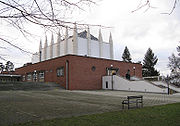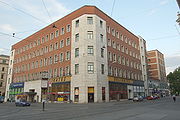
Arnošt Wiesner
Encyclopedia
Ernst Wiesner, also known as Arnošt Wiesner (January 21, 1890, in Malacky
, Kingdom of Hungary
, Austro-Hungarian Empire - July 15, 1971, in Liverpool
) was a modernist architect
, one of the foremost interwar period architects of Brno
.
During 1908 to 1913 Wiesner studied at the Technical College and the Academy of Arts (taught by B. Ohmann) in Vienna
. After the World War I
he worked as an independent architect in the city of Brno
, until 1939. Wiesner was a very active architect in the city between the World Wars. His work was greatly influenced by Adolf Loos
and his pure constructions with their classicized balance and monumentality are amongst the best works to be constructed in Brno at that time.
Afterwards Wiesner emigrated to Great Britain
where he joins the foreign anti-fascist resistance. After World War II
he stayed in England. During 1948-50 he acted as a lecturer in the School of Architecture at the University of Oxford
and during 1950-60 at the University of Liverpool
. In 1969 he was nominated to the rank of honorary doctor by the University of Jan Evangelista Purkyně (now Masaryk University
) in Brno.


Malacky
Malacky is a town and municipality in western Slovakia around 35 km north from capital Bratislava. From the second half of the 10th century until 1918, it was part of the Kingdom of Hungary...
, Kingdom of Hungary
Kingdom of Hungary
The Kingdom of Hungary comprised present-day Hungary, Slovakia and Croatia , Transylvania , Carpatho Ruthenia , Vojvodina , Burgenland , and other smaller territories surrounding present-day Hungary's borders...
, Austro-Hungarian Empire - July 15, 1971, in Liverpool
Liverpool
Liverpool is a city and metropolitan borough of Merseyside, England, along the eastern side of the Mersey Estuary. It was founded as a borough in 1207 and was granted city status in 1880...
) was a modernist architect
Architect
An architect is a person trained in the planning, design and oversight of the construction of buildings. To practice architecture means to offer or render services in connection with the design and construction of a building, or group of buildings and the space within the site surrounding the...
, one of the foremost interwar period architects of Brno
Brno
Brno by population and area is the second largest city in the Czech Republic, the largest Moravian city, and the historical capital city of the Margraviate of Moravia. Brno is the administrative centre of the South Moravian Region where it forms a separate district Brno-City District...
.
During 1908 to 1913 Wiesner studied at the Technical College and the Academy of Arts (taught by B. Ohmann) in Vienna
Vienna
Vienna is the capital and largest city of the Republic of Austria and one of the nine states of Austria. Vienna is Austria's primary city, with a population of about 1.723 million , and is by far the largest city in Austria, as well as its cultural, economic, and political centre...
. After the World War I
World War I
World War I , which was predominantly called the World War or the Great War from its occurrence until 1939, and the First World War or World War I thereafter, was a major war centred in Europe that began on 28 July 1914 and lasted until 11 November 1918...
he worked as an independent architect in the city of Brno
Brno
Brno by population and area is the second largest city in the Czech Republic, the largest Moravian city, and the historical capital city of the Margraviate of Moravia. Brno is the administrative centre of the South Moravian Region where it forms a separate district Brno-City District...
, until 1939. Wiesner was a very active architect in the city between the World Wars. His work was greatly influenced by Adolf Loos
Adolf Loos
Adolf Franz Karl Viktor Maria Loos was a Moravian-born Austro-Hungarian architect. He was influential in European Modern architecture, and in his essay Ornament and Crime he repudiated the florid style of the Vienna Secession, the Austrian version of Art Nouveau...
and his pure constructions with their classicized balance and monumentality are amongst the best works to be constructed in Brno at that time.
Afterwards Wiesner emigrated to Great Britain
Great Britain
Great Britain or Britain is an island situated to the northwest of Continental Europe. It is the ninth largest island in the world, and the largest European island, as well as the largest of the British Isles...
where he joins the foreign anti-fascist resistance. After World War II
World War II
World War II, or the Second World War , was a global conflict lasting from 1939 to 1945, involving most of the world's nations—including all of the great powers—eventually forming two opposing military alliances: the Allies and the Axis...
he stayed in England. During 1948-50 he acted as a lecturer in the School of Architecture at the University of Oxford
University of Oxford
The University of Oxford is a university located in Oxford, United Kingdom. It is the second-oldest surviving university in the world and the oldest in the English-speaking world. Although its exact date of foundation is unclear, there is evidence of teaching as far back as 1096...
and during 1950-60 at the University of Liverpool
University of Liverpool
The University of Liverpool is a teaching and research university in the city of Liverpool, England. It is a member of the Russell Group of large research-intensive universities and the N8 Group for research collaboration. Founded in 1881 , it is also one of the six original "red brick" civic...
. In 1969 he was nominated to the rank of honorary doctor by the University of Jan Evangelista Purkyně (now Masaryk University
Masaryk University
Masaryk University is the second largest university in the Czech Republic, a member of the Compostela Group and the Utrecht Network. Founded in 1919 in Brno as the third Czech university , it now consists of nine faculties and 42,182 students...
) in Brno.


Architectural works in Brno
- Gutmannův dům (Gutmann's house) 1919-22
- Moravská zemská životní pojišťovna (Moravian Municipal Life Insurance Company) 1920-1923
- Česká banka Union later Čs. rozhlas (Czech Union Bank later Czechoslovakian Broadcast) 1923-26
- Krematorium (Crematorium) 1926-29
- Palác MoravaPalace MoraviaPalace Moravia is a building in City of Brno, Czech Republic.In 1926 an architectonical competition for the model of a hotel was announced. This was supposed to be built on a place of former music-hall building. Beside home-born also such world-known architects as Peter Behrens and Jacobus Oud had...
(Palace Moravia) 1927-29. Completely finished in 1936 - Rodinný dvojdům (Double-family house) 1928
- Moravská banka (Moravian bank) 1929-30, co-author Bohuslav FuchsBohuslav FuchsBohuslav Fuchs was a Czech modernist architect.A mason by education, he studied at Academy of Fine Arts in Prague in 1916-1919 by Jan Kotěra and then he worked in Kotěra's atelier for two years. From 1922 he resided in Brno, where he worked at city construction office and later in his own atelier...
- Činžovní dům Freundschaft (The Freundschaft tenement house) 1930-31
- Various family houses, industrial and manufacturing buildings around the City of Brno

